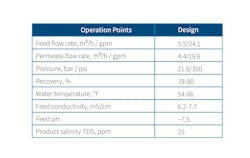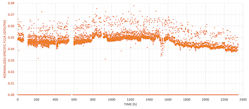Treating wastewater is a necessity. Whether it is for industrial or municipal applications, wastewater treatment facilities are installed for several reasons: to comply with discharge regulations, to reuse and reclaim water due to water scarcity, and for the economical consideration derived from the costs of freshwater supply and effluent disposal.
Though the installation, operation and maintenance costs of such systems can be high, there are ways to maximize design in order to deliver the most optimal solution in terms of cost and performance. The main goal for the performance is to increase the recovery rate of the system as much as possible. This allows for the reclamation of more water for reuse which will reduce fresh water supply costs. In addition, it will reduce the amount of brine that has to be disposed of, which, in some cases, produces significant costs.
Conventional water treatment technologies are limited in their ability to provide high recovery. Industrial and municipal wastewater are typically characterized by very challenging water characteristics. While each case is unique and different, such water usually contains various sparingly soluble salts, metals and organics. When concentrated in a reverse osmosis (RO) system, those components tend to form scale, fouling and bio-fouling, which jeopardize membrane integrity. As a result, the recovery rate of conventional wastewater treatment systems is limited. Increasing the recovery in such conventional systems may yield more reclaimed water and less brine to be disposed, but at a high cost. It will require frequent membrane replacements, as well as shutdowns for membrane cleanings, resulting in lower system availability. In addition to the high operational costs derived from membrane cleanings and replacements, the resulting lower system availability may require an installation of a system with significant redundancy designed to ensure sufficient availability, thus increasing capital expenses.
In order to enjoy the benefits of high recovery, there is a need for a cost-effective solution that can push wastewater reuse to its limit, without increasing capital and operations costs, and thus solving many of the industry's water challenges.
Pulse flow reverse osmosis
Conventional RO operates in stable hydraulic and osmotic conditions which increase the tendency for scaling and fouling. In addition, these stable conditions enable bacteria to thrive on the RO membranes and thus form biofouling. IDE Technologies’ proprietary Pulse Flow Reverse Osmosis (PFRO) technology, on the other hand, utilizes mechanical and chemical techniques to solve these common RO challenges. It does so by constantly changing the flow regime and the osmotic and hydraulic pressure. By doing that, the PFRO system enables an increase in water recovery without increasing membrane cleanings or replacements.
Contrary to the standard RO process, PFRO discharges the brine flow periodically, in a pulse flow process comprised of short periodic cycles. The production cycle is shorter than the induction time of the sparingly soluble salts existing in the concentrated brine, therefore eliminating scale formation.
Each cycle of PFRO includes two modes: production and flushing. During production mode, the brine valve is closed and there is no brine discharge, which means that 100% of the feed flow is passing to the permeate side. During flushing mode, the brine valve opens for a short period of time, enabling brine to discharge at a high velocity. This creates short and rapid pulses with high shear force that help keep the membranes free from fouling.
The PFRO production and flushing cycles are of different pressure vessels (PVs) in the system and are synchronized to maintain constant feed, permeate and brine flows over time. The pressure vessels are divided into groups, and each one has a single brine valve that periodically opens and closes and controls the pulse flow operation. Only a small fraction of the PVs is in a flushing mode at any given time, enabling the high-pressure pump to operate in a stable working manner.
Unlike the conventional multi-stage RO train approach, the PFRO configuration is a single-stage RO train (see Figure 1).
Case Study: Abilene Hargesheimer Water Treatment Plant
How does PFRO work in action? The Texas-based Abilene Hargesheimer Water Treatment Plant faced a significant challenge when it tried to reduce its concentrated brine effluent flow while avoiding heavy maintenance and operational load. Prior to implementing PFRO, the plant desalinated water from a nearby lake using a Brackish Water Reverse Osmosis (BWRO) system with a recovery rate of 80%, while the remaining brine was discharged into evaporation ponds. However, the ponds are limited by size and cannot handle the RO brine reject load. In order to lower the amount of brine flow in the ponds, the plant used an enhanced evaporation system of spraying water (turbo misters). This method created an environmental nuisance to the nearby residents due to convection of salt droplets by the wind, so a different approach needed to be taken.
Given the high calcium sulfate, calcium carbonate and barium sulfate concentrations, it was not feasible to use a conventional RO system to reduce the RO brine flow by increasing recovery rate because it would immediately result in severe scale formation, and cause the RO membranes to go out of service.
For this particular case, PFRO technology was implemented to treat the existing BWRO brine reject. The goal was to achieve an additional 80% recovery on top of the BWRO 80% recovery, bringing the overall recovery to 96%.
Overview of the demonstration system
The PFRO demonstration plant in Abilene was composed of two 8” pressure vessels in series. Each pressure vessel included four Dow FILMTEC SW30-XLE-400 membrane elements in a single stage operation. Feed water quality of the BWRO brine reject, which is the PFRO feed, is detailed in Table 1.
The rejected brine from the existing RO includes calcium sulfate and calcium carbonate in supersaturation concentrations, such that it could not be further concentrated in a standard RO process.
Results and discussion
The PFRO demo unit, which operated from March 2021 through June 2021 as part of an acceptance test, was a success. The operating parameters, including specific flux, head loss and permeate conductivity, were constantly monitored and showed a very stable performance, and indicated that there was no accumulation of scaling or fouling. There were also no periodic shutdowns for cleaning required. See the operating conditions in Table 2.
In order to examine PFRO’s ability to operate at the desired recovery without compromising the system integrity, we may look at the specific flux. The specific flux is a measure of the energy efficiency of the system, and is used as an indication of fouling and scaling status. As can be seen in Figure 2 below, the specific flux was stable over time at around 0.039-0.051 gfd/psi. Fluctuations in specific flux can be explained by varying feed conductivity. As a basis for comparison, in many conventional, well-functioning BWRO plants, the specific flux constantly declines at a rate of 10% to 15% every three months, at which time clean-in-place (CIP) is usually performed. Even though there were extremely challenging conditions in this case, the results indicate that the demand of the PFRO demo unit for CIP was significantly lower compared to traditional RO systems.
Conclusion
As global populations increase and industrial demand intensifies, wastewater treatment technologies will become a go-to solution for reducing our reliance on natural resources. Though the optimal wastewater treatment solution will always depend on a variety of factors including regulation and maintenance requirements, wastewater quality, capital expenses, freshwater availability and more, the Abilene case study has proven that PFRO is an excellent, cost-effective option for water reclamation.
Matan Hameiry is product manager at IDE Technologies.






